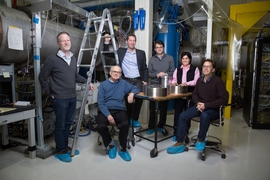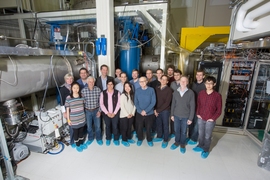Almost 100 years ago today, Albert Einstein predicted the existence of gravitational waves — ripples in the fabric of space-time that are set off by extremely violent, cosmic cataclysms in the early universe. With his knowledge of the universe and the technology available in 1916, Einstein assumed that such ripples would be “vanishingly small” and nearly impossible to detect. The astronomical discoveries and technological advances over the past century have changed those prospects.
Now for the first time, scientists in the LIGO Scientific Collaboration — with a prominent role played by researchers at MIT and Caltech — have directly observed the ripples of gravitational waves in an instrument on Earth. In so doing, they have again dramatically confirmed Einstein’s theory of general relativity and opened up a new way in which to view the universe.
But there’s more: The scientists have also decoded the gravitational wave signal and determined its source. According to their calculations, the gravitational wave is the product of a collision between two massive black holes, 1.3 billion light years away — a remarkably extreme event that has not been observed until now.
The researchers detected the signal with the Laser Interferometer Gravitational-wave Observatory (LIGO) — twin detectors carefully constructed to detect incredibly tiny vibrations from passing gravitational waves. Once the researchers obtained a gravitational signal, they converted it into audio waves and listened to the sound of two black holes spiraling together, then merging into a larger single black hole.
“We’re actually hearing them go thump in the night,” says Matthew Evans, an assistant professor of physics at MIT. “We’re getting a signal which arrives at Earth, and we can put it on a speaker, and we can hear these black holes go, ‘Whoop.’ There’s a very visceral connection to this observation. You’re really listening to these things which before were somehow fantastic.”
By further analyzing the gravitational signal, the team was able to trace the final milliseconds before the black holes collided. They determined that the black holes, 30 times as massive as our sun, circled each other at close to the speed of light before fusing in a collision and giving off an enormous amount of energy equivalent to about three solar masses — according to Einstein’s equation E=mc2 — in the form of gravitational waves.
“Most of that energy is released in just a few tenths of a second,” says Peter Fritschel, LIGO’s chief detector scientist and a senior research scientist at MIT’s Kavli Institute for Astrophysics and Space Research. “For a very short amount of time, the actual power in gravitational waves was higher than all the light in the visible universe.”
These waves then rippled through the universe, effectively warping the fabric of space-time, before passing through Earth more than a billion years later as faint traces of their former, violent origins.
“It’s a spectacular signal,” says Rainer Weiss, a professor emeritus of physics at MIT. “It’s a signal many of us have wanted to observe since the time LIGO was proposed. It shows the dynamics of objects in the strongest gravitational fields imaginable, a domain where Newton’s gravity doesn’t work at all, and one needs the fully non-linear Einstein field equations to explain the phenomena. The triumph is that the waveform we measure is very well-represented by solutions of these equations. Einstein is right in a regime where his theory has never been tested before.”
The new results are published today in the journal Physical Review Letters.
“Magnificently in alignment”
The first evidence for gravitational waves came in 1974, when physicists Russell Hulse and Joseph Taylor discovered a pair of neutron stars, 21,000 light years from Earth, that seemed to behave in a curious pattern. They deduced that the stars were orbiting each other in such a way that they must be losing energy in the form of gravitational waves — a detection that earned the researchers the Nobel Prize in physics in 1993.
Now LIGO has made the first direct observation of gravitational waves with an instrument on Earth. The researchers detected the gravitational waves on September 14, 2015, at 5:51 a.m. EDT, using the twin LIGO interferometers, located in Livingston, Louisiana and Hanford, Washington.
Each L-shaped interferometer spans 4 kilometers in length and uses laser light split into two beams that travel back and forth through each arm, bouncing between precisely configured mirrors. Each beam monitors the distance between these mirrors, which, according to Einstein’s theory, will change infinitesimally when a gravitational wave passes by the instrument.
“You can almost visualize it as if you dropped a rock on the surface of a pond, and the ripple goes out,” says Nergis Malvalvala, the Curtis and Kathleen Marble Professor of Astrophysics at MIT. “[It’s] something that distorts the space time around it, and that distortion propagates outward and reaches us on Earth, hundreds of millions of years later.”
Last March, researchers completed major upgrades to the interferometers, known as Advanced LIGO, increasing the instruments’ sensitivity and enabling them to detect a change in the length of each arm, smaller than one-ten-thousandth the diameter of a proton. By September, they were ready to start observing with them.
“The effect we’re measuring on Earth is equivalent to measuring the distance to the closest star, Alpha Centauri, to within a few microns,” Evans says. “It’s a very tough measurement to make. Einstein expected this to never have been pulled off.”
Nevertheless, a signal came through. Using Einstein’s equations, the team analyzed the signal and determined that it originated from a collision between two massive black holes.
“We thought it was going to be a huge challenge to prove to ourselves and others that the first few signals that we saw were not just flukes and random noise,” says David Shoemaker, director of the MIT LIGO Laboratory. “But nature was just unbelievably kind in delivering to us a signal that’s very large, extremely easy to understand, and absolutely, magnificently in alignment with Einstein’s theory.”
For LIGO’s hundreds of scientists, this new detection of gravitational waves marks not only a culmination of a decades-long search, but also the beginning of a new way to look at the universe.
“This really opens up a whole new area for astrophysics,” Evans says. “We always look to the sky with telescopes and look for electromagnetic radiation like light, radio waves, or X-rays. Now gravitational waves are a completely new way in which we can get to know the universe around us.”
Tiny detection, massive payoff
LIGO research is carried out by the LIGO Scientific Collaboration (LSC), a group of some 950 scientists at universities around the United States, including MIT, and in 15 other countries. The LIGO Observatories are operated by MIT and Caltech. The instruments were first explored as a means to detect gravitational waves in the 1970s by Weiss, who along with Kip Thorne and Ronald Drever from Caltech proposed LIGO in the 1980s.
“This has been 20 years of work, and for some of us, even more,” Evans says. “It’s been a long time working on these detectors, without seeing anything. So it’s a real sea change and an interesting psychological change for the whole collaboration.”
“The project represents a triumph for federally funded research,” says Maria Zuber, vice president for research and E. A. Griswold Professor of Geophysics at MIT. “LIGO is an example of a high-risk, high-return investment in discovery-driven science. In this case the investment was major and sustained over many years, with a successful outcome far from assured. But the scientific payoff is shaping up to be extraordinary. While the discoveries reported here are already magnificent, they represent the tip of the iceberg of what will be learned about fundamental physics and the nature of the universe.”
The LIGO Observatories are due for more upgrades in the near future. Currently, the instruments are performing at one-third of their projected sensitivity. Once they are fully optimized, Shoemaker predicts that scientists will be able to detect gravitational waves emanating “from the edge of the universe.”
“In a few years, when this is fully commissioned, we should be seeing events from a whole variety of objects: black holes, neutron stars, supernova, as well as things we haven’t imagined yet, on the frequency of once a day or once a week, depending on how many surprises are out there.” Shoemaker says. “That’s our dream, and so far we don’t have any reason to know that that’s not true.”
As for this new gravitational signal, Weiss, who first came up with the rudimentary design for LIGO in the 1970s as part of an experimental exercise for one of his MIT courses, sees the tiny detection as a massive payoff.
“This is the first real evidence that we’ve seen now of high-gravitational field strengths: monstrous things like stars, moving at the velocity of light, smashing into each other and making the geometry of space-time turn into some sort of washing machine,” Weiss says. “And this horrendously strong thing made a very tiny effect in our apparatus, a relative motion of 10 to the minus 18 meters between the mirrors in the interferometer arms. It’s sort of unbelievable to think about.”
This research was funded by the National Science Foundation.






















